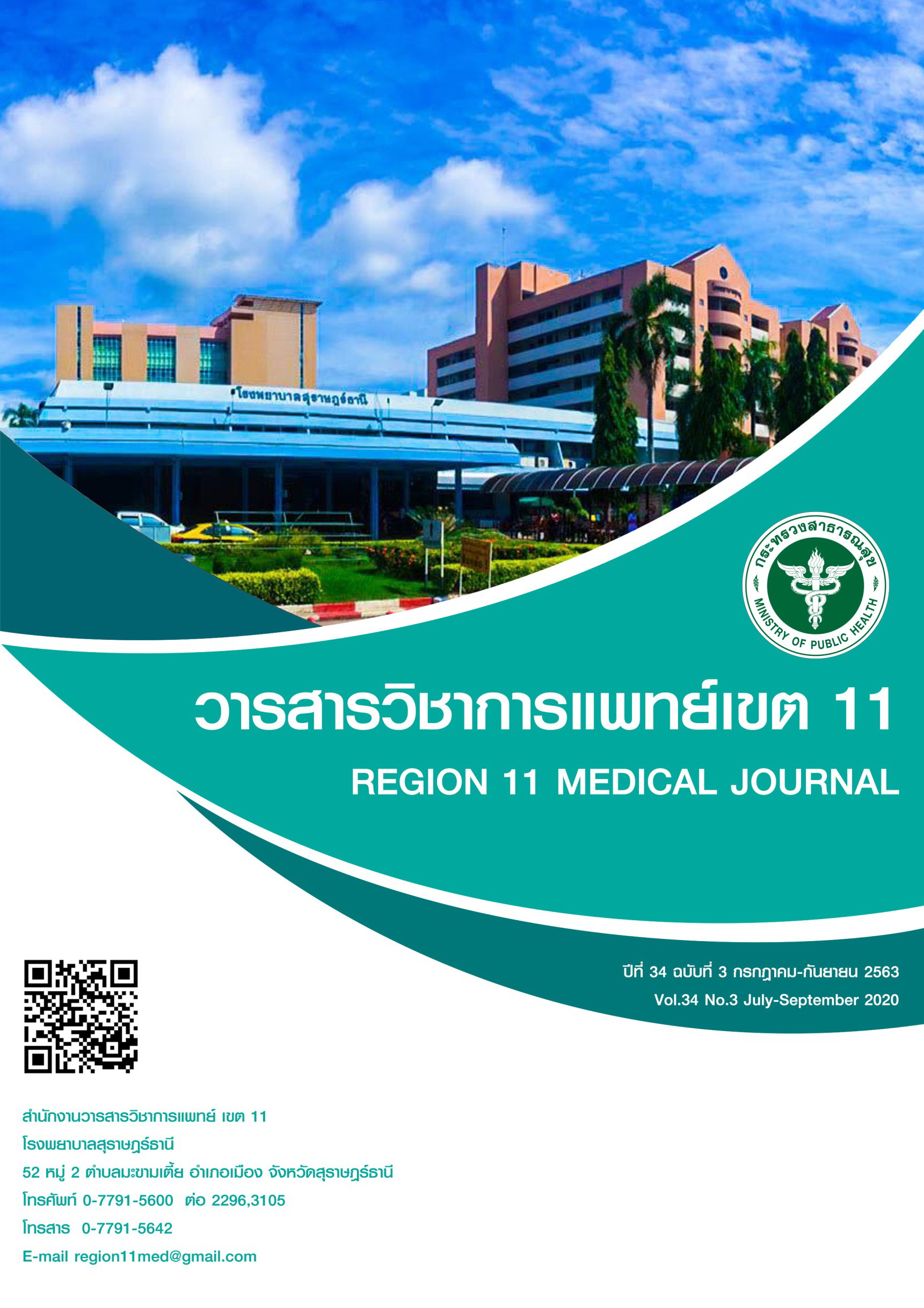A Study of the Maternal Risk Factors for Low Birth Weight Infants in Huaiyot Hospital, Trang
DOI:
https://doi.org/10.14456/reg11med.2020.5Keywords:
Low birth weight infant, Risk factorAbstract
Background: Low birth weight infants have a high mortality rate, chronic illness and disability, as well as developmental abnormalities higher than normal weight infants. These major problems should be considered in Thailand because of an important indicator which indicates the quality of obstetric care.
Objectives: To study the risk factors affecting mothers with LBW infants in Huaiyot Hospital.
Methodology: A case control study was performed. 1,423 mothers who delivered during October 1, 2015 to September 30, 2018 in Huaiyot Hospital were included in the study. 116 mothers who delivered infants of weight < 2,500 gm. and the rest 1,307 mothers who delivered infants weight ≥2,500 gm. Characters of population were described with number and percent. Data were analyzed by chi-square test, odds ratio (OR) and multiple logistic regression analysis.
Results: The incidence of LBW infants was 8.15%. From the multivariable analysis was achieved, the only five risk factors were significant reliable. The highest was nulliparous, maternal gestational age < 37 weeks, obstetric complication, maternal weight gain < 10 kg. and hemoglobin level < 11 g/dl. (Adjusted OR = 0.41, 10.57, 3.79, 9.88, 2.39 respectively)
Conclusions: nulliparous, maternal gestational age < 37 weeks, obstetric complication, maternal weight gain < 10 kg, and hemoglobin level < 11 g/dl were significant maternal risk factors of LBW infants.
References
World Health Organization. Low birthweight: country, regional and global estimates. World Health Organization, Geneva, and UNCEF, New York; 2004.
Cunningham FG, Leveno KJ, Bloom SL, Spong CY, Dashe JS, Hottman BL, et al. Fetal-growth disorders. In: Williams Obstetrics. 25th ed. New York: McGraw-Hill Professional. 2018:844-56.
Anderson MS, Hay WW Jr. Intrauterine growth restriction and the small for gestational age infant. In: Avery GB, Fletcher AM, MacDonald MG, editors. Neonatology, pathophysiology and management of the newborn. 5th ed. Philadelphia: Lippincott William & Wilkins; 1999:411-44.
ศิริกุล อิศรานุรักษ์. ทารกน้ำหนักแรกเกิดน้อย:ปัญหาสุขภาพคนไทยที่ยังแก้ไม่ตก. วารสารสาธารณสุขและการพัฒนา. 2549;4:67-73.
สำนักส่งเสริมสุขภาพ กรมอนามัย. คู่มือการดำเนินงานโรงพยาบาลสายใยรักครอบครัว ภายใต้ชุดสิทธิประโยชน์หลักประกันสุขภาพถ้วนหน้าด้านส่งเสริมป้องกัน และเฝ้าระวังการเจ็บป่วยกลุ่มหญิงมีครรภ์และเด็กแรกเกิด – 5 ปี พ.ศ. 2551. นนทบุรี: กรมอนามัย; 2550.
Tantayakom C, Prechapanich J. Risk of Low Birth Weight Infantsfrom Adolescent Mothers: Review Case Study in Siriraj Hospital. Thai Journal of Obstetrics and Gynaecology. 2008;16:103-8.
นงลักษณ์ ทองโต. ปัจจัยเสี่ยงต่อการให้กำเนิดทารกแรกเกิดน้ำหนักน้อยในประเทศไทย. วารสารประชากร. 2553;3:53-68.
ภัทรวดี อัญชลีชไมกร. ปัจจัยที่มีความสัมพันธ์กับการเกิดทารกแรกเกิดน้ำหนักน้อย โรงพยาบาลเจ้าพระยายมราช จังหวัดสุพรรณบุรี. วารสารพยาบาลกระทรวงสาธารณสุข. 2556;21:71-9.
เอดิ ปริยาโน, ศิริกุล อิศรานุรักษ์, จิราพร ชมพิกุล. ปัจจัยเสี่ยงด้านมารดาที่มีผลต่อการเกิดทารกน้ำหนักแรกเกิดน้อย ณ โรงพยาบาลเฟทมาวาติ กรุงจาการ์ตา ประเทศอินโดนีเซีย. วารสารสาธารณสุขและการพัฒนา. 2551;6:123-33.
สินาท พรหมมาศ. การศึกษาปัจจัยเสี่ยงที่มีความสัมพันธ์กับทารกแรกเกิดน้ำหนักน้อยในโรงพยาบาลภูมิพลอดุลยเดช. แพทยสารทหารอากาศ. 2533;35(1):67-75.
อรพินท์ กอสนาน. ผลต่อการเกิดทารกแรกเกิดน้ำหนักน้อย ในโรงพยาบาลบางน้ำเปรี้ยว. วารสารศูนย์การศึกษาแพทยศาสตร์คลินิก โรงพยาบาลพระปกเกล้า. 2556;30:287-99.
ปิยะนุช พรหมสาขา ณ สกลนคร. ความสัมพันธ์ระหว่างปัจจัยส่วนบุคคล พฤติกรรมส่งเสริมสุขภาพขณะตั้งครรภ์กับน้ำหนักตัวทารกแรกเกิด. วารสารโรงพยาบาลสกลนคร. 2559;19:1-11.
รุ่งนภา รู้ชอบ, นิตยา สินสุกใส, วรรณา พาหุวัฒนกร, ณัฐกานต์ บริบูรณ์หิรัญสาร. ปัจจัยทำนายการคลอดทารกแรกเกิดน้ำหนักน้อย. วารสารพยาบาลศาสตร์. 33:18-29.
กรวิกา ภู่พงศ์พันธ์กุล, ปัทมา สุพรรณกุล, ฉันทนา จันทร์บรรจง, ถาวร มาต้น. การวิเคราะห์อิทธิพลเส้นทางปัจจัยที่มีความสัมพันธ์เชิงสาเหตุกับทารกแรกคลอดน้ำหนักน้อยในโรงพยาบาลสายใยรักแห่งครอบครัว : กรณีศึกษาพื้นที่เขตตรวจราชการที่ 8. วารสารการพยาบาลและสุขภาพ. 2557;8(3):118-34.
สันสนีย์ หาญพินิจศักดิ์. ปัจจัยเสี่ยงต่อการเกิดทารกแรกเกิดน้ำหนักน้อยโรงพยาบาลส่งเสริมสุขภาพ ศูนย์อนามัยที่ 6 ขอนแก่น. ขอนแก่นเวชสาร. 2550;31:34-42.
Tshotetsi L, Dzikiti L, Hajison P, Feresu S. Maternal factors contributing to low birth weight deliveries in Tshwane District, South Africa. PloS one. 2019;14(3):e0213058.
Kramer MS. Determinants of low birth weight: methodological assessment and meta-analysis. Bulletin of the world health organization. 1987;65(5):663-737.
Ramakrishnan U. Nutrition and low birth weight: from research to practice. The American journal of clinical nutrition. 2004;79(1):17-21.
ACOG Committee on Practice Bulletins Obstetrics. ACOG Practice Bulletin No. 419: Use of progesterone to reduce preterm birth. Obstet Gynecol. 2008;112:963-5
Sunsaneevithayakul P, Titapant V, Ruangvutilert P, Sutantawibul A, Phatihattakorn C, Wataganara T, et al. Relation between gestational weight gain and pregnancy outcomes. J Obstet Gynaecol Res. 2014;40:995-1001.
Thanaratsiriworakul K, Suriya N, Sananpanichkul P. Comparison of gestational weight gain recommendations between study from Thai population and U.S. institute of medicine. Thai journal of obstetrics and gynaecology. 2016;24:161-8.
Cunningham FG, Leveno KJ, Bloom SL, Spong CY, Dashe JS, Hottman BL, et al. Hematological disorders. In: Williams Obstetrics. 25th ed. New York: McGraw-Hill Professional. 2018:1075-77.






